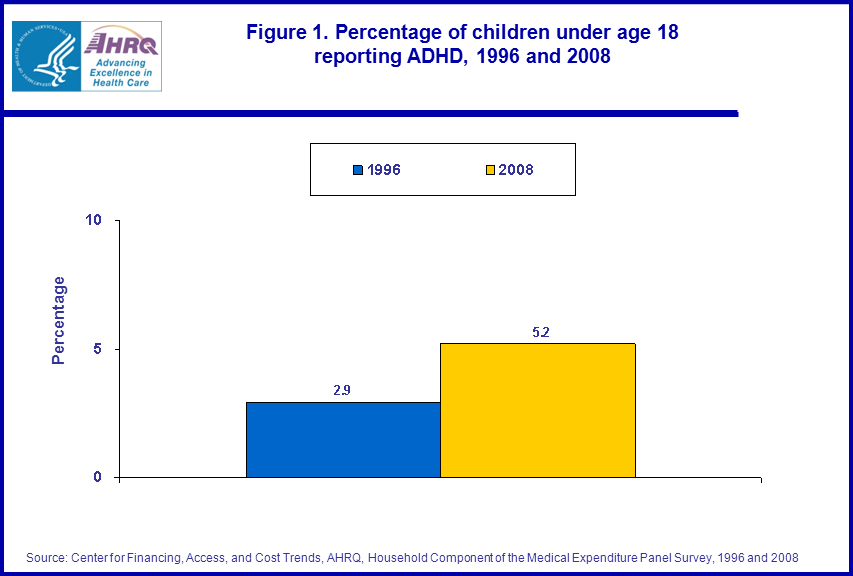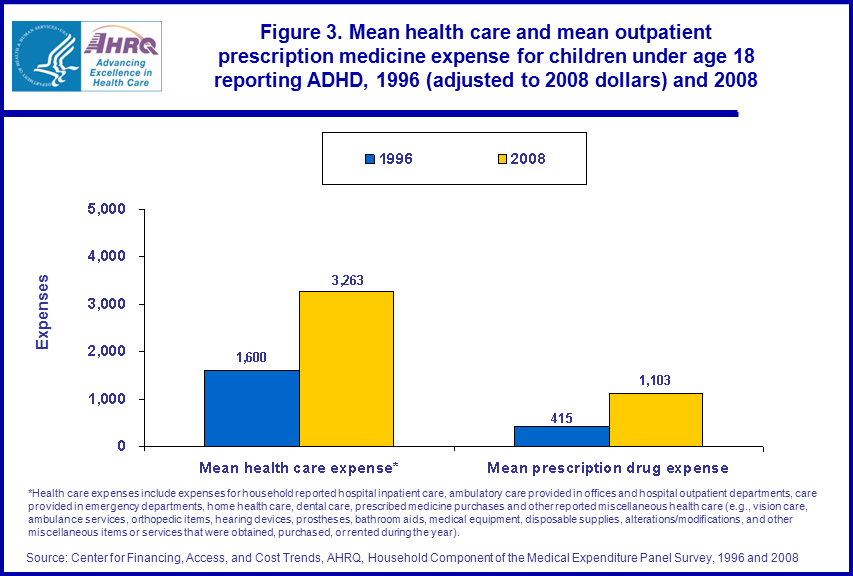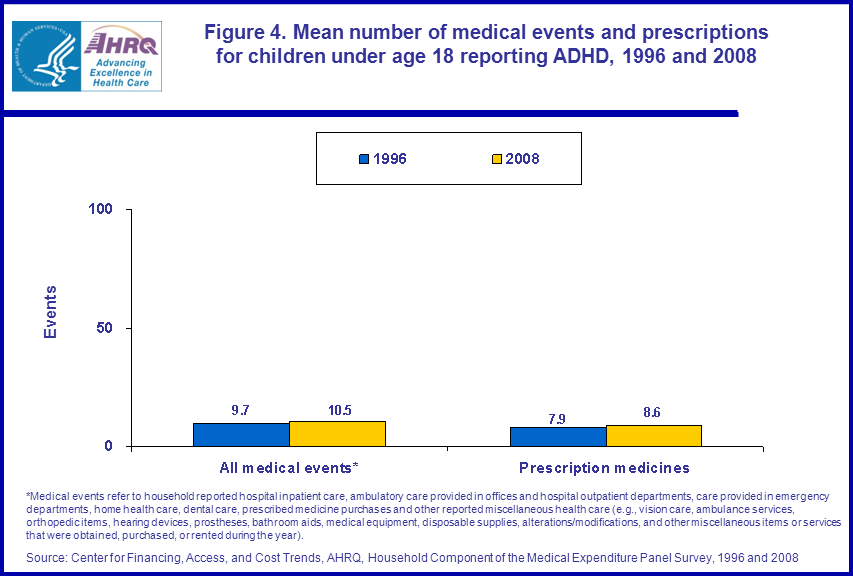
|
|
Font Size:
|
||||
|
|
|
|
||||
STATISTICAL BRIEF #324:
Trends in Health Care Expenses and Utilization for Children under Age 18 Reporting Attention Deficit Hyperactivity Disorder in the U.S. Civilian Noninstitutionalized Population, 1996 and 2008
Highlights
- When comparing 1996 to 2008, for children under age 18, the proportion reporting attention deficit hyperactivity disorder increased from 2.9 percent to 5.2 percent.
- When comparing 1996 to 2008, among those under age 18 reporting attention deficit hyperactivity disorder, total prescription drug expenses increased more than 350 percent from $0.9 billion to $4.3 billion.
- Total expenses for those under age 18 reporting attention deficit hyperactivity disorder increased more than 250 percent, from $3.3 billion to $12.6 billion when comparing 1996 with 2008.
- In 1996, the average annual prescription drug expense for children under age 18 reporting attention deficit hyperactivity disorder was $415, and by 2008, the average annual prescription drug expense more than doubled, to $1,103.
Introduction
This Statistical Brief presents trends in health care and prescription drug utilization and expenses for children under age 18 reporting attention deficit hyperactivity disorder (ADHD) for the years 1996 and 2008. Examining these data provides valuable insight into the spending, utilization, and prescription drug patterns for children with ADHD. The estimates are for the U.S. civilian noninstitutionalized population and are derived from the 1996 and 2008 Household Component of the Medical Expenditure Panel Survey (MEPS-HC).Expenses in this Brief are presented in real dollars; estimates for 1996 were adjusted to 2008 dollars using the GDP Price Index (http://www.meps.ahrq.gov/mepsweb/about_meps/Price_Index.shtml).
All differences discussed in the text are statistically significant at the 0.05 level.
Findings
In 1996, there were 71.5 million children under age 18 in the U.S. noninstitutionalized civilian population and the proportion reporting attention deficit hyperactivity disorder (ADHD) was 2.9 percent (2.1 million children). In 2008, the total number of children under age 18 in the U.S civilian noninstitutionalized population was 74.3 million and the proportion reporting attention deficit hyperactivity disorder (ADHD) rose to 5.2 percent (3.9 million children) (figure 1).Total health care expenses for children age 17 and younger reporting ADHD was $3.3 billion in 1996 and increased over 250 percent to $12.6 billion in 2008. Moreover, for children under age 18 reporting ADHD, total prescription drug expenses increased from $0.9 billion in 1996 to $4.3 billion in 2008—more than a 350 percent increase (figure 2).
In 1996, children age 17 and younger reporting ADHD reported a mean for all medical events of 9.7, and in 2008 the mean number of total medical events for children under age 18 reporting ADHD was 10.5, not a significant increase. This trend held true for the mean number of prescription drug purchases, as well—there was no significant increase in the mean number of prescription drug purchases by children reporting ADHD in 2008 compared with 1996 (8.6 and 7.9, respectively) (figure 4).
Data Source
The estimates shown in this Statistical Brief are based on data from MEPS HC-012: 1996 Full Year Consolidated Data File, MEPS HC-006R: 1996 Medical Conditions File, MEPS HC-121: 2008 Full Year Consolidated Data File, and MEPS HC-120: 2008 Medical Conditions File.Definitions/Methodology
AgeAge is the last available age for the sampled person. For most persons, this was their age at the end of the year.
Medical conditions
Condition data were collected from household respondents during each round as verbatim text and coded by professional coders using the International Classification of Diseases, Ninth Revision (ICD-9). For this Statistical Brief, the following ICD-9 code was used for Attention Deficit Hyperactivity Disorder: ICD-9 = 314.
Medical events
Medical events in this Brief refer to household reported hospital inpatient care, ambulatory care provided in offices and hospital outpatient departments, care provided in emergency departments, home health care, dental care, prescribed medicine purchases, and other reported miscellaneous health care (e.g., vision care, ambulance services, orthopedic items, hearing devices, prostheses, bathroom aids, medical equipment, disposable supplies, alterations/modifications, and other miscellaneous items or services that were obtained, purchased, or rented during the year).
Expenses
Expenses refer to what is paid for health care services. More specifically, expenses in MEPS are defined as the sum of direct payments for care provided during the year, including out-of-pocket payments and payments by private insurance, Medicaid, Medicare, and other sources. Payments for over-the-counter drugs are not included in MEPS expenses. Indirect payments not related to specific medical events, such as Medicaid Disproportionate Share and Medicare Direct Graduate Medical Education subsidies, are also excluded.
Expenses may be associated with more than one condition and are not unduplicated in the condition totals; summing over conditions would double-count some expenses. Total spending does not include amounts for other medical expenses, such as durable and nondurable supplies, medical equipment, eyeglasses, ambulance services, and dental expenses, because these items could not be linked to specific conditions.
Expenses are expressed in real dollars; estimates for 1996 were adjusted to 2008 dollars based on the GDP Implicit Price Deflator (http://www.meps.ahrq.gov/mepsweb/about_meps/Price_Index.shtml).
About MEPS
MEPS-HC is a nationally representative longitudinal survey that collects detailed information on health care utilization and expenditures, health insurance, and health status, as well as a wide variety of social, demographic, and economic characteristics for the U.S. civilian noninstitutionalized population. It is cosponsored by the Agency for Healthcare Research and Quality and the National Center for Health Statistics.For more information about MEPS, call the MEPS information coordinator at AHRQ (301) 427-1656 or visit the MEPS Web site at http://www.meps.ahrq.gov/.
References
For a detailed description of the MEPS-HC survey design, sample design, and methods used to minimize sources of nonsampling error, see the following publications:Cohen, J. Design and Methods of the Medical Expenditure Panel Survey Household Component. MEPS Methodology Report No. 1. AHCPR Pub. No. 97-0026. Rockville, MD. Agency for Health Care Policy and Research, 1997. http://www.meps.ahrq.gov/mepsweb/data_files/publications/mr1/mr1.shtml
Cohen, S. Sample Design of the 1996 Medical Expenditure Panel Survey Household Component. MEPS Methodology Report No. 2. AHCPR Pub. No. 97-0027. Rockville, MD. Agency for Health Care Policy and Research, 1997. http://www.meps.ahrq.gov/mepsweb/data_files/publications/mr2/mr2.shtml
Cohen, S. Design Strategies and Innovations in the Medical Expenditure Panel Survey. Medical Care, July 2003: 41(7) Supplement: III-5—III-12.
Ezzati-Rice, T.M., Rohde, F., Greenblatt, J. Sample Design of the Medical Expenditure Panel Survey Household Component, 1998–2007. Methodology Report No. 22. March 2008. Agency for Healthcare Research and Quality, Rockville, MD. http://www.meps.ahrq.gov/mepsweb/data_files/publications/mr22/mr22.pdf
Suggested Citation
Stagnitti, M.N. Trends in Health Care Expenses and Utilization for Children under Age 18 Reporting Attention Deficit Hyperactivity Disorder in the U.S. Civilian Noninstitutionalized Population, 1996 and 2008. Statistical Brief #324. May 2011. Agency for Healthcare Research and Quality, Rockville, MD. http://www.meps.ahrq.gov/mepsweb/data_files/publications/st324/stat324.shtmlAHRQ welcomes questions and comments from readers of this publication who are interested in obtaining more information about access, cost, use, financing, and quality of health care in the United States. We also invite you to tell us how you are using this Statistical Brief and other MEPS data and tools and to share suggestions on how MEPS products might be enhanced to further meet your needs. Please e-mail us at mepspd@ahrq.gov or send a letter to the address below:
Steven B. Cohen, PhD, Director
Center for Financing, Access, and Cost Trends
Agency for Healthcare Research and Quality
540 Gaither Road
Rockville, MD 20850
 |
|||||||||||||||
|
|||||||||||||||
|
|
|||||||||||||||
 |
|||||||||||||||
|
|||||||||||||||
|
|
|||||||||||||||
 |
|||||||||||||||
|
|||||||||||||||
|
|
|||||||||||||||
 |
|||||||||||||||
|
|||||||||||||||
|
|
|||||||||||||||


